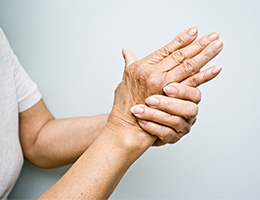
For some people with arthritis, winter seems to be the most painful time of the year. But you don't have to go south to find relief. A few simple strategies can make the season more bearable.
What is arthritis?
Arthritis isn't one disease. It's actually a term that encompasses more than 100 different conditions, according to the Arthritis Foundation.
The Centers for Disease Control and Prevention estimates that over 53 million adults in the U.S. have some type of doctor-diagnosed arthritis. The most common form is osteoarthritis. Other forms of arthritis include rheumatoid arthritis, psoriatic arthritis and gout.
All forms of arthritis affect the body's joints—causing pain, stiffness, inflammation and even deformity.
Arthritis can make it difficult to do basic tasks, such as walking, climbing stairs, using a keyboard or even brushing your teeth.
Does winter weather affect arthritis?
Some people seem more sensitive to weather than others. However, that doesn't mean that some people are imagining things, notes the Foundation. It just means that people don't always perceive things in the same way.
Scientific research suggests that cold, wet weather is a factor for arthritis symptoms. Here's a review of what some studies have found:
- In a survey-based 2014 study of people with osteoarthritis, 67% of participants said that weather affected their joint pain. A 2011 article found similar results in people with rheumatoid arthritis.
- A 2015 study of people with osteoarthritis found links between humidity, temperature and joint pain. The effect of humidity on pain was stronger when the weather was colder.
- Another 2015 study found that people with rheumatoid arthritis said they experienced fewer symptoms when the days were sunny and dry.
Why does the weather affect arthritis?
We don't know for sure why changes in the weather affect arthritis pain. Changes in barometric pressure—a measure of the weight of the air—can cause expansion and contraction of tendons, muscles, bones and scar tissue. Cold temperatures also might thicken joint fluids, making joints feel stiffer and possibly more sensitive to pain during movement.
People are also less active during inclement weather, and inactivity can contribute to more arthritis pain.
Coping with the weather
If your arthritis worsens in the winter, but you can't pack up and move to warmer climes, there are still several steps you can take to alleviate your symptoms.
Here are some tips for adapting to winter life:
Balance activity with rest. Painful symptoms may have you longing to stay in bed and rest all day, but that's not the best approach. Instead, combine periods of rest with light activity. Make sure to pace yourself, and don't overdo it.
Apply hot or cold packs to your joints. According to the Foundation, heat can ease joint pain by increasing blood flow to the affected area and relaxing the muscles. Use heating pads, warm compresses or take warm baths. Cold reduces inflammation by constricting blood vessels. Take care not to overdo either treatment.
Seek support from family and friends. Let the people in your life know when you're in pain. Ask for help if you need it. Be proactive and discuss your arthritis issues with your employer, too, if you're worried that your arthritis might affect your ability to work. That way, everyone can be prepared to cope when you have a bad flare-up.
Talk with your doctor. Come up with a plan of action for times when you're feeling more pain than usual. For example, you might discuss making an adjustment in your medications.